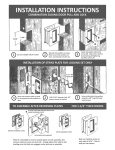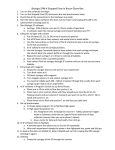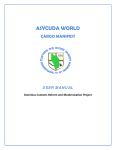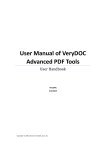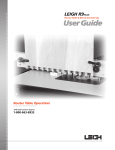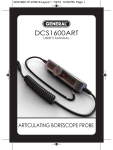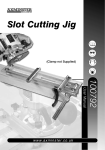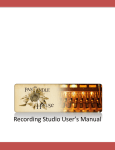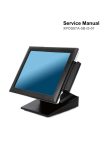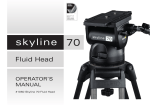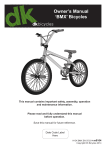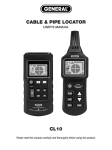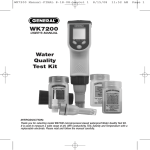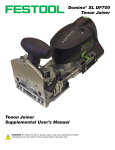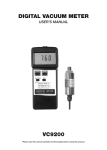Download No. 870 - General Tools And Instruments
Transcript
No. 870 USER’S MANUAL (U.S. PATENTS APPLIED FOR) PLEASE READ THESE INSTRUCTIONS FULLY BEFORE USING THIS JIG www.generaltools.com/woodworking CONTENTS Introduction . . . . . . . . . . . . . . . . . . . . . . . . . . . . . . . . . . . . . . . . . . . . . . . . . . 3 Capacity and Specifications . . . . . . . . . . . . . . . . . . . . . . . . . 3 What’s in the Jig Kit . . . . . . . . . . . . . . . . . . . . . . . . . . . . . . . . 3 Anatomy of the Jig . . . . . . . . . . . . . . . . . . . . . . . . . . . . . . . . . . . . . . . . . . . . . 4 Anatomy of the “Quick Change” Router Base Bushing Assembly . . . . . . 4 Preparing the Router . . . . . . . . . . . . . . . . . . . . . . . . . . . . . . . . . . . . . . . . 5 – 6 Safety Overview . . . . . . . . . . . . . . . . . . . . . . . . . . . . . . . . . . . 5 Installing the “Quick Change” Guide Sleeve . . . . . . . . . . . . 5 Centering the Base Plate and the “Quick Change Guide System” . . . . . . . . . . . . . . . . . . . . . . . 5 Setting the Cutting Depth . . . . . . . . . . . . . . . . . . . . . . . . . . . 6 Mounting the Jig . . . . . . . . . . . . . . . . . . . . . . . . . . . . . . . . . . . . . . . . . . . . . . 6 Operating Instructions . . . . . . . . . . . . . . . . . . . . . . . . . . . . . . . . . . . . . 7 – 12 1. Marking Joint Centers and Location . . . . . . . . . . . . . . . . 7 2. Centering the Stock . . . . . . . . . . . . . . . . . . . . . . . . . . . . . . 7 3. Positioning the Stock using the Positioning Bars . . . . . . 8 4. Setting the Joint Length . . . . . . . . . . . . . . . . . . . . . . . . . . . 9 Length of Mortise & Tenon Chart . . . . . . . . . . . . . . . . . . . 9 5. Setting the Depth of the Router Bit . . . . . . . . . . . . . . . . . 10 6. Routing the Tenon . . . . . . . . . . . . . . . . . . . . . . . . . . . . . . . 11 7. Routing the Mortise . . . . . . . . . . . . . . . . . . . . . . . . . . . . . 12 Routing Other Size Mortise and Tenons . . . . . . . . . . . . . . . . . . . . . . . . . . 13 Customer Support . . . . . . . . . . . . . . . . . . . . . . . . . . . . . . . . . . . . . . . . . . . . 14 Warranty Information . . . . . . . . . . . . . . . . . . . . . . . . . . . . . . . . . . . . . . . . . 14 Notes . . . . . . . . . . . . . . . . . . . . . . . . . . . . . . . . . . . . . . . . . . . . . . . . . . . . . . . 15 Sample Mortise & Tenon Joint 2 INTRODUCTION Thank you for purchasing General Tools & Instruments’ E-Z ™ Pro Combination Mortise & Tenon Jig (M&T Jig)— the woodworking industry’s first integrated jig capable of making matching mortise and tenon joints of professional quality “right out of the box.” The jig makes creating Mortise & Tenon joints—the sturdiest of all wood joints—for furniture, cabinets and frames – an easy, simple, and fast process. The Mortise & Tenon Kit comes with a fully assembled jig and includes a 1/4" straight up-cut router bit and 1/4" guide bushing. Also included are the guide bushings for cutting 3/8" and 1/2" joints. You will need to supply your own 3/8" and 1/2" upcut router bits. The M&T Jig has a one-piece heat treated, high grade aluminum body, with its adjusting bolts, up-cut fasteners and bit made of steel to SAE specifications. The unit’s adjustable positioning bars and router bushing assembly are also made of solid steel. Capacity and Specifications: Accommodates stock from 1/2" to 1½" thick and any length Mortise and Tenon thickness: 1/4", 3/8" and 1/2" Minimum length M&T Joint: 1" +/- 1/8" (depending on bit used) Maximum Length M&T Joint: 3" +/- 1/8" (depending on bit used) What’s in the M&T Jig Kit 1. The fully assembled jig 2. “Quick Change” Router Base Bushing Assembly consists of: • One “Quick Change” 1-3/16" guide sleeve and locking nut 1 • One 1/4" guide bushing (1-1/4" OD) • One 1/4" shank centering pin • One flat spanner wrench for guide sleeve locking nut adjustment • One 3/8" guide bushing 2 • One 1/2" guide bushing 3. One 1/4" straight upcut spiral carbide router bit 3 It is highly recommended that you familiarize yourself with the nomenclature in Fig. 1 and Fig. 2 on p. 4 before proceeding. 3 ANATOMY OF THE E-Z PRO MORTISE & TENON JIG Fig. 1 JIG ASSEMBLY IN PROFILE 4C JIG ASSEMBLY MORTISE SECTION 1 - Jig Assembly 1A - Centering Marks TENON SECTION 5 - Face Clamp Thumb Screws 6 - Positioning Bars 1B - Centering Notches 6A - Positioning Bars deployed 1C - Template Positioning Indicators 6B - Positioning Bars retracted for storage and cutting 2 - Mortise Section Templates 2B - Template Position Rule 3 - Tenon Section Templates 7 - Face Clamps 8 - Mounting Flange 4 - Centering Wall, [4A] Markings, [4B] Serrations, [4C] Thumb Screws ANATOMY OF THE “QUICK CHANGE” ROUTER BASE BUSHING ASSEMBLY: Fig. 2 R1 - Lock Nut R5 - Flat Spanner Wrench R2 - 1-3/16" Router Base Guide Sleeve R6 - 7/8" O.D. Router Guide Bushing for the 3/8" Tenon R3 - 1-1/8" O.D. Router Guide Bushing for the 1/4" Tenon (as well as for all mortises) R4 - Centering Pin 4 R7 - 5/8" O.D. Router Guide Bushing for the 1/2" Tenon R8 - 1/4" Upcut Routing Bit PREPARING THE ROUTER SAFETY OVERVIEW 1. KNOW YOUR ROUTER. Read the owner’s manual that came with your router before you use it. Understand the machine’s applications and limitations, as well as the specific potential hazards inherent in its use. Before using the router, check that none of its moving parts is broken, loose or misaligned. NOTE: General Tools & Instruments is not responsible for router misuse or the disregard of standard safety precautions associated with using a router. Installing the “Quick Change” guide sleeve The E•Z Pro M&T Jig is designed to be used with plunge routers with base plates with a 1-3/16" center hole and a 1-3/8" counter-bore. This is to accommodate the included “Quick Change” guide sleeve and bushing. If your router base cannot mate with the guide sleeve, you can purchase a “Universal Router Plate” with the appropriate center hole dimensions to attach to or replace your current router base. With the proper base plate installed, 1. Insert the Guide Sleeve [R-2] into the Base Plate. 2. Secure the Lock Nut [R-1] firmly with the flat Spanner Wrench Provided. 3. Screw the 1-1/8" Router Guide Bushing [R-3] into the center of the guide sleeve and hand tighten. (Fig. 3) Fig. 3 BASE PLATE WITH 1-3/16" CENTER HOLE AND A 1-3/8" COUNTER Fig. 4 Centering the Base Plate and the “Quick Change Guide System” 1. With your router upside down, plunge the base and lock it. 2. Insert the 1/4" Centering Pin [R-4] in the router chuck and tighten it securely. 3. Loosen the mounting screws of the base plate just enough to allow a little movement. (Fig. 4) 4. Carefully release the plunge lock and gently guide the plunge base to extension on the cone section of the centering pin; (Fig. 5) this allows the loosened base plate to move on its screw holes to a perfect centering position. Fig. 5 5. Tighten the base plate screws securely. 5 Fig. 6 • Once you have completed this centering operation, remove the centering pin from the router and replace it with the router bit. Setting the Cutting Depth • Set the depth of your plunge router for the desired depth of your mortise and tenon. • When the stock is correctly mounted in the jig, its top edge will be 1/2" below the top (working) surface of the jig (Fig.7a). • Accordingly, add 1/2" to the desired depth of the mortise and tenon when setting the “plunge” depth of the router (Fig.7b). Fig. 7A POSITIONING ARM SHOWN DEPLOYED FROM THE FACE OF THE BASE PLATE TO THE TIP OF THE CUTTING BIT EQUALS THE DEPTH OF THE JOINT PLUS 1/2" Fig. 7B ROUTER IN THE FULLY PLUNGED POSITION MOUNTING THE JIG The M&T Jig can be mounted directly on the edge of a bench using the integral mounting flange [9] (Fig. 8A), or secured to a mounting board which can then be clamped to a bench (Fig. 8B). WORK BENCH Fig. 8A 6 WORK BENCH Fig. 8B OPERATING INSTRUCTIONS: 1. Marking Joint Centers and Location Mark the stock with center marks at the positions for the tenon and the mortise. These marks will be needed to center the tenon section and the longitudinal position of the mortise on the stock. If you have correctly set the centering wall for the thickness of the stock, the stock will automatically be centered** for stock thickness when clamped in the jig. **Tip: if there is a variation in the thickness of the stock used, you may adjust for this by use of appropriate shims or by readjusting the centering bar. CENTER POSITION OF THE TENON CENTER POSITION OF THE MORTISE Fig. 9 TENON SECTION MORTISE SECTION 2. Centering the Stock • Centering the stock in the jig is accomplished by adjusting the centering wall [4] (Fig.10) for the thickness of the stock. • The jig will handle stock with a thickness between 1/2" and 1-1/2". • Using the lumber industry’s nomenclature, these two thicknesses, designated as, “2 quarter” (1/2") and “6 quarter” (1-1/2"), indicating the number of 1/4" increments of thickness. Fig. 10 • The markings are on the tenon end of the Centering Wall [4A]. Use these “quarter” units to adjust for the thickness of your stock in “quarters”. For example: if you are using 3/4" (three quarter) stock, align the number “3” with the inner wall of the jig (Fig. 11), and the stock will be at its nominal center in the templates. • When adjusting the Centering Wall, and to maintain parallel alignment, always make sure the bar is correctly seated on the jib body with its serrated matching surface [4B] (Fig.11) in the jig. Tips: to assure an accurate joint alignment, particularly if you are making a face frame or similar matching surface type joint, always keep the matching faces to the same side of the jig. Fig. 11 7 3. Positioning the Stock Using the Positioning Bars When in the deployed position (Fig 12), the Positioning Bars serve two basic purposes: 1. They position the stock at the correct depth below the underside of the template for routing 2. They align the stock so it is squared, at 90 degrees, to the jig longitudinally 6A Fig. 13 Fig. 12 The Positioning Bars [Fig 12 and 13] are stored along the inside edge of the underside of the jig’s top when routing. 1. To extend the bars, use the Positioning Bar handles [6A], located under the outside top edge. Fig. 14 2. After you fully deploy the Positioning Bars, you’re ready to place the stock in the jig. Insert the stock gently up against the deployed Positioning Bars (Fig. 14) and tighten the Thumb Screws [5] just enough so the stock is held loosely by the Face Clamps [7]. 3. Center the stock longitudinally using the jig’s centering marks [1A] on the jig (Fig. 15). Before tightening the Face Clamps, be sure the stock is flat and square against the Positioning Bars (but not too tight) and correctly centered. 4. Tighten the Face Clamps, enough to secure the stock from moving. 5. Using their handles, return the Positioning Bars to their storage position (Fig15). IN USE POSITION Fig. 15 8 STORED FOR ROUTING 4. Setting the Joint Length The M&T jig has two working sections, the mortise section and the tenon section (Fig. 16). Fig. 16 2 2 2B 2 2 2B 1C TENON SECTION MORTISE SECTION Each section is equipped with left and right Adjustable Sliding Templates [#2] (Fig.16) that are used to set the length of the cut. There are 0, 1/2 and 1 marks alongside each template’s edge [2B]. When you set the size of the opening, make sure that ALL of the templates indicate the same measurement; this assures that the cut will be centered. (Fig. 16) To adjust the templates for the desired joint length, loosen the Lock Screws on the right and left template and slide them to the desired equal position (as indicated with the Template Positioning Rules [2B]), and re-tighten the screws. When the “0” on the template positioning rule [2B] is aligned with the Template Position Indicator [1C] on the jig surface, the template is open to its longest position and approximates a 3" long joint** (Fig. 16). When the “1” is aligned with the template position indicator [1C], the template is closed to its shortest position and approximates a 1" joint**. These are actually fractional inch markings and refer to the amount of template closure. For example, if you set the templates to 1/2 it means that you’re reducing the (approx**) 3" long joint by a 1/2" on each side. Therefore your joint size will be (approx**) 2". Or, if you set the template to 3/4 you’ll be taking 3/4" from each side of the joint resulting in a joint length of (approx**) 1-1/2". Please note: the chart below indicates the exact length of each joint for each marking on the template and for each bit size. Make the same ruler settings to both templates on the mortise side as well as to both sides of the tenon side to have a centered and matching mortise and tenon. (Fig. 18) ** For exact joint lengths for each size bit, please refer to the sizing chart below Length of Mortise and Tenon Chart Template Position Markings Joint Thickness 0 1/8 1/4 3/8 1/2 5/8 3/4 7/8 1 1/4 2-7/8 2-5/8 2-3/8 2-1/8 1-7/8 1-5/8 1-3/8 1-1/8 7/8 3/8 3 2-3/4 2-1/2 2-1/4 2 1-3/4 1-1/2 1-1/4 1 1/2 3-1/8 2-7/8 2-5/8 2-3/8 2-1/8 1-7/8 1-5/8 1-3/8 1-1/8 9 The jig itself has two Centering Marks [1A] (Fig. 17) on its top surface that which indicate the longitudinal center of the templates. There are also Centering Notches [1B] on the deployed Positioning Bars [6]; they indicate the center of the template’s width. To keep the joint centered longitudinally, always make the same template position setting to all templates. Fig. 17 5. Set the Depth of the Router Bit (See also “Setting the Cutting Depth” on page 6) To set the “plunge” depth of the router (Fig. 18) and subsequently the cutting depth of the bit, remember to add 1/2" to the desired depth of the joint. Therefore, if you’re setting the joint depth to be 1" then your measurement would be a total of 1-1/2" from the face of the base plate to the tip of the bit. FROM THE FACE OF THE BASE PLATE TO THE TIP OF THE CUTTING BIT EQUALS THE DEPTH OF THE JOINT PLUS 1/2" Fig. 18 10 Fig. 19 6. Routing the Tenon When routing the tenon, make sure the Guide Bushing [R-3] only rides against the outer edges of the tenon template [3] (Fig. 19) at all times. 1. Start the cut by putting the guide bushing into the end of the template. 1/4" UP CUT BIT SHOWN R-3 GUIDE BUSHING 3 2. With the guide bushing in the end of the template and the router base squarely on the jig surface, turn the router on. 3. Plunge the router to a workable depth and guide the router bit clockwise through the cutting process making sure to keep the Guide Bushing tight to the outer edge at all times. NOTE: You can make successive plunges to any depth while moving the Guide Bushing clockwise around the tenon template always riding against the edge to make the cleanest joint possible. We recommend making successive shallow plunges and cutting sweeps to avoid over stressing the cutting bit. (Fig. 19 & 20) Fig. 20 Caution: before retracting the router bit from the cut, be sure to turn the router off. Tip: depending on the actual thickness of your stock, you may at times get a “fence” or “flash” around the edge of your tenon (Fig 21). Be sure to cut, file or sand it off cleanly to ensure a tight fit. Fig. 21 11 2 Fig. 22 7. Routing the Mortise Tip: when routing the mortise, it is advisable to increase the depth of cut slightly more than that of the tenon to allow space for glue to be put on the tenon before inserting it into the mortise. The Guide Bushing [R-3] fits the Mortise Template [2] (Fig. 22) exactly to prevent it from wandering out of line. It will be used for all mortises regardless of size. Fig. 23 1. Before turning on the router, place the guide bushing in the end of the mortise template and slide it through the template to be sure it moves freely. (Fig. 23) 2. With the guide bushing in the end of the template and the router base squarely on the jig surface, turn the router on. 3. Plunge the router and guide the router bit through the cutting process. NOTE: We recommend cutting the mortise in successive overlapping plunges to depth and then repeatedly move the bit back and forth to clean up the mortise slot. The method you use is up to your experience on how to obtain the best cut. 12 ROUTING OTHER SIZE MORTISE AND TENONS The E•Z Pro Mortise and Tenon Jig Kit includes the guide sleeve with Locking Nut [R2, R1], a 1-1/8" Router Guide Bushing for 1/4" joints [R3], a 1/4" Upcut Spiral Router Bit and a Centering Pin [R4]. These parts will permit you to make 1/4" mortises and tenons suitable for 3/4" thick board (Fig 24). The kit also includes the Guide Bushings you will need to make mortises and tenons of 1/2" [R7] or 3/8" [R6] (Page 4), however, you will need to make a separate purchase of the corresponding upcut spiral bits. Please see sizing chart on Page 10. • To make a 3/8" tenon, you’ll need a 3/8" Upcut Spiral Bit and the 7/8" Guide Bushing [R6]. • To make the matching 3/8" mortise, change to the 1-1/8" Guide Sleeve [R-3]. (Fig. 25) • To make a 1/2" tenon, you’ll need a 1/2" Upcut Spiral Bit and the 5/8" Guide Bushing [R7]. • To make the matching 1/2" mortise, change to the 1-1/8" Guide Sleeve [R-3]. (Fig. 26) NOTE: Guide bushings can be changed without removing router bit. Fig. 24 1/4" JOINT (shown on 1" stock) MORTISE TENON MORTISE TENON Fig. 25 3/8" JOINT (shown on 1-1/4" stock) Fig. 26 1/2" JOINT (shown on 2" stock) MORTISE TENON 13 CUSTOMER SUPPORT Please visit our website at www.generaltools.com/woodworking to obtain additional woodworking information, instructional videos and product manual. http://www.generaltools.com/Products/E-Z-Pro-Mortise-and-Tenon-Jig__870.aspx WARRANTY INFORMATION The No. 870 Mortise & Tenon Jig Kit from General Tools & Instruments is warranted to the original purchaser to be free from defects in material and workmanship for a period of one year. Subject to certain restrictions, General will repair or replace this product, if, after examination, it is determined by General to be defective in material or workmanship. 14 NOTES _______________________________________________________________________ _______________________________________________________________________ _______________________________________________________________________ _______________________________________________________________________ _______________________________________________________________________ _______________________________________________________________________ _______________________________________________________________________ _______________________________________________________________________ _______________________________________________________________________ _______________________________________________________________________ _______________________________________________________________________ _______________________________________________________________________ _______________________________________________________________________ _______________________________________________________________________ _______________________________________________________________________ _______________________________________________________________________ _______________________________________________________________________ _______________________________________________________________________ _______________________________________________________________________ _______________________________________________________________________ 15 GENERAL TOOLS & INSTRUMENTS 80 White Street, New York, NY 10013-3567 PHONE (212) 431-6100 FAX (212) 431-6499 TOLL FREE (800) 697-8665 e-mail: [email protected] www.generaltools.com 870 User’s Manual Specifications subject to change without notice ©2011 GENERAL TOOLS & INSTRUMENTS NOTICE - WE ARE NOT RESPONSIBLE FOR TYPOGRAPHICAL ERRORS. MAN#870 3/22/11
















